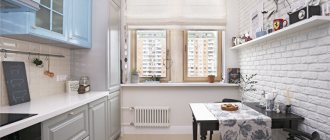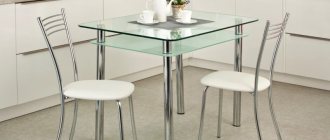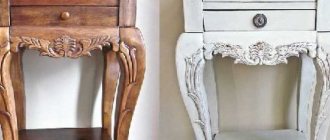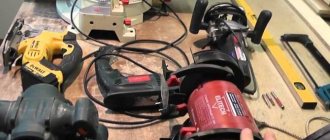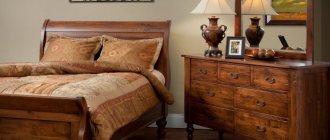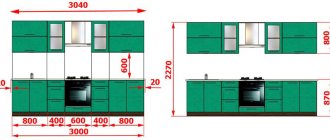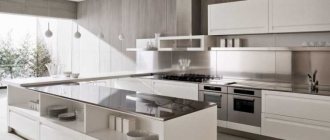11191
Many apartments are considered not very comfortable residential buildings, since all the rooms in them are extremely small. This leads to certain difficulties in the process of their arrangement. Particularly many problems arise when choosing furniture for the kitchen, since there must be many specific interior items, and at the same time it is often simply impossible to find the best option. An excellent solution for such a room is modular kitchen furniture; with the help of elements, a complete structure is obtained for a high-quality and optimal cooking process.
What is a modular kitchen?
A modular kitchen can be called a construction kit for adults. Typically, a manufacturing company produces several construction blocks within one collection. It is best to consider this concept with an example. Ikea was one of the first on the market to start producing modular kitchens, so in honor of respect, let's take it as an example, namely its Knoxhult series. It is available in several colors, consider gray - it’s in the photo.
Like any kitchen cabinets, modular ones can also be divided into upper and lower.
There are three types of wall cabinets:
- single;
- double;
- single narrow for hood.
And there are three floor cabinets:
- narrow, consisting entirely of drawers (40 cm wide);
- cabinet with doors, drawer and space for embedding a stove (width 180 cm);
- wardrobe with drawer and two doors (width 120 cm).
A modular kitchen is a new solution on the market, in which the buyer independently creates his own kitchen from blocks: this is what distinguishes it from a conventional built-in kitchen set.
They can be arranged in different ways: you can buy several floor cabinets with a width of 40 centimeters and be satisfied with only them. Such a designer makes the imagination work.
Summarizing
There are different systems for hanging and floor elements. These can be islands, shelves, separate modules for drying and for dishes. There are open and closed shelves, and consumers will also find corner shelves in stores. Drying modules are most often installed under the sink; a tray is placed at the bottom of the module, which collects water from the dishes. Wall-mounted models for dishes can have decorative walls; there are also elements with blank doors on sale.
Separately, it is worth mentioning pencil cases or columns. Such modules occupy space from floor to ceiling; a refrigerator or other household appliances can be installed in the columns. Pencil cases are used to store containers for jam or other utensils.
The best posts
- How to update old interior doors: DIY restoration
- Crochet stole: pattern and description of knitting capes for women with photos and videos
- DIY candy strawberries: master class with photos and videos
- Bouquet of felt flowers for March 8
- What kind of ceiling design can you make in the hall with your own hands?
- Bathroom 2 sq. m. - little secrets of successful design
- How to weave a peacock feather from rubber bands on a slingshot and on a machine with video
- Comfortable bedroom with attached balcony
Pros and cons of buying a ready-made kitchen
Of course, such a new phenomenon immediately has supporters and opponents. The latter cannot come to terms with the fact that they don’t have to wait for a kitchen for several weeks, as before, but assemble it themselves from blocks. To understand how to feel about such a new piece of furniture, it’s worth understanding all the advantages and disadvantages of the product.
Advantages
Block kitchens are quickly gaining popularity, due to the large number of advantages of such a solution:
- a design project is not needed, since all modules are standard. The buyer himself selects the necessary elements and combines them at his own request. On the websites of retail stores there are often design programs where it is easy to select the necessary modules for a specific room;
- Collections most often contain several types of modules, among which you can always find what you need;
- suitable for both large and small kitchens;
- calculation of the cost of the kitchen becomes absolutely transparent;
- you can easily update the interior;
- the ability to purchase a separate module;
- installation is so easy that you can do it yourself;
- budget cost;
- simplicity - in fact, this is a ready-made solution from which you just need to select the necessary elements;
- easy to transport;
- high functionality;
- The wait for the kitchen is reduced to a minimum - most often it is in stock in the store itself, but sometimes there is a need to wait for delivery from the warehouse.
Look how many advantages have accumulated. Modular kitchen - it's fast, cheap, easy!
Selection of material and assembly of the headset according to the diagram
Having chosen the wall configuration, dimensions and arrangement of elements, you need to decide on the material from which your kitchen modules will be made. Moreover, this applies to the front part of the furniture, the frame, and the countertop.
Frame according to finished drawings
There are two types of frames - glued and prefabricated. The first is ready-made modules for the kitchen, delivered to the buyer already assembled. The second option is assembled into a furniture set on site. And the manufacturing material, regardless of the assembly method, is laminated chipboard. Using wood for this purpose is expensive and impractical, and is only used if the facade is made of the same material.
The frame is the basis for assembling a kitchen set
Facade
Often, when choosing a material for a kitchen wall, they have in mind the façade part. It is made from materials with varying strength, environmental friendliness and service life. The better the parameters, the more expensive ready-made modular kitchens will cost, a quarter of the cost of which is occupied by the facade.
The most common kitchen walls are made of the following materials:
- Chipboard. Suitable for inexpensive facades and kitchens where cooking is rare, since the material does not like high temperatures and humidity;
- laminated chipboard. Slightly better than the previous version in terms of decorative and operational parameters, but also inferior to other materials;=
- MDF. Modular kitchens of this type can withstand frequent cooking and are available in both film and painted versions. The second option looks more attractive, but requires special care (when wiped with powder, the surface is severely scratched);
- The most expensive modular kitchens made from solid natural wood. They will also require a wooden frame. They can withstand moisture, but are not resistant to temperature changes.
- Other options such as plastic, glass and aluminum are also used, but less frequently. And their cost, parameters and type depend on the manufacturer.
WATCH THE VIDEO
Components
The number and types of modules differ not only between different companies, but also in different series of the same company. For this reason, finding the perfect lockers can be quite difficult. But in the end, you will get a kitchen that best meets the needs of the housewife - cooking with this is a joy.
Wall cabinets most often come in the following types:
- with drying - they are placed directly above the sink;
- tableware (rarely found among modular ones) - with a glazed facade, behind which a beautiful service can be seen;
- open - without door. Perfect for a country or Provence style kitchen;
- straight, blind - the most ordinary cabinet with the usual door.
It is worth noting that this difference is only in appearance. They can also vary in size. This also applies to the lower level headset. The most commonly presented modules here are:
- under the sink - a necessary thing in every kitchen;
- with shelves - most often they are wide and designed for storing large utensils (pans and pots);
- with drawers - a very practical module, where there is more effective space compared to the usual option with shelves;
- combined - universal modules with both shelves and drawers;
- with a niche for built-in equipment - you should select based on the availability, type and size of the equipment itself;
- pencil case - a tall narrow cabinet.
One series does not necessarily contain all of the above modules. The manufacturer may have only two upper and three lower ones. When choosing, you should proceed from your needs: if there is no built-in equipment, then you don’t need a cabinet for it.
Disadvantages of modular furniture
Among the disadvantages of modular furniture, it is worth noting the likelihood of gaps appearing between several modules. They usually occur due to uneven floors, as well as an error in the selection of elements.
Before you go to the store, you need to decide on the style of the interior. If you want to buy a modular kitchen for a small space, you should remember that the simpler the style, the better the interior.
Furniture made in modern and high-tech styles looks good in small kitchens. When purchasing, you should give preference to those sets that have muted tones of the facade. Furniture in light colors looks good. Such items will visually expand the space and will not clutter up the kitchen. It is not recommended to choose modules with brightly colored facades for small spaces.
Related article: Silver paint without silver with unique properties
Light-colored modules will visually expand the space
It is best to purchase several cabinets and cabinets. You shouldn’t fill all the free corners with objects; this approach will avoid unnecessary cluttering of the space. In order to divert attention from a small area of the room, you should pay attention to cabinets with mirror surfaces.
Don't buy a kitchen corner; it's better to stick with a table and chairs. This will significantly save space. Be sure to do a design project, think about where you can place the refrigerator.
It should be noted that today almost all kitchens are selected based on the principle of assembling modular elements. This means that each buyer, having looked at the catalog, can choose the most suitable configuration of the kitchen set, focusing on the desired appearance, size and functionality of the furniture. In stores, an experienced manager helps the buyer make a choice. This allows the client to receive an individually selected headset at the best price.
For a small kitchen it is not recommended to choose modules with bright facades
In the catalog of many stores you can choose elements from a variety of materials. Ready-made modular systems are a good way to create functional space in the kitchen.
Standard module sizes
Dimensions may vary among different companies. The record holder here is Ikea with its 180 cm in the lower tier and 120 cm in the upper. Usually these values are much more modest, and the essence is this: one cabinet - one module.
Hence the standard module width:
- 45 cm,
- 50 cm;
- 60 cm;
- 75 cm;
- 80 cm.
This dispersion is due to the fact that different companies have different views on kitchen units, and they cannot come to a common decision.
It is best to first measure the existing kitchen that needs a new set, and then draw a rough plan yourself. Then, according to this plan, it will be much easier to select the necessary modules, because household appliances such as a refrigerator, stove, hood, dishwasher or washing machine, and so on will already be taken into account.
The only thing that almost all manufacturers agreed on was the height of the lower tier. In modular kitchens it reaches 85 cm, taking into account the base (10 cm) and countertop. This is a comfortable height for people of average height (160–175 cm); others should think about trimming the base or additional legs.
It is important to consider the depth of the cabinets - it is also quite standard:
- 30–40 cm - for the upper tier;
- 60 cm - for the lower tier.
In this case, the tabletop should be 63–65 cm deep so that it forms a small canopy over the facades. Typically, modular kitchens already come with an ideal-sized countertop.
Standard set
Due to the fact that all modular kitchens from IKEA and other manufacturers look standard, you do not have to turn to professional designers to develop entire layout projects.
You just need to measure the dimensions of the kitchen and select cabinets and cabinets based on these dimensions.
Types of modular cabinets
If you decide to install a modular kitchen, you need to know that they come in different types. There are differences in the type of layout, type of opening or type of installation.
But, it must be honestly noted, these factors very rarely become decisive when choosing a block kitchen. First of all, they look at the appearance, content and cost.
Layout
Most often, the modular kitchen itself does not imply any specific layout. But with its help you can create all of the following options:
- linear - the most common option for arranging furniture, the essence of which is that all cabinets are placed on only one wall. This layout will suit any room. Most often there are both wall and floor cabinets. The ease of arrangement leaves plenty of room for a varied arrangement of modules and decor. Another small advantage is that the fewer cabinets, the lower the cost;
- parallel - with this layout, furniture is placed on two opposite walls. There is a lot of storage space, so you can often see a refusal to use wall cabinets. This layout greatly affects the geometry of the room - visually it becomes narrow, so the dining area is moved to another room;
- corner - another standard layout option that is suitable for any kitchen. As the name implies, cabinets are placed on both sides of one corner, that is, on adjacent walls. This layout is considered one of the best because it creates an ideal work triangle;
- U-shaped — arranging furniture in a U shape is suitable for spacious rooms. Cabinets can stand along three or two walls. In the latter case, instead of cabinets, a bar counter is usually installed, which at the same time zones the space. The dining area is most often removed from the kitchen, but sometimes it is located near the fourth wall;
- island - a very beautiful and multifunctional furniture layout option, in which several floor cabinets are placed in the center of the kitchen, forming an island. But modular kitchens are considered budget-friendly, so it’s very difficult to find options for an island here.
The advantage of modular kitchens is that if the housewife initially wanted a corner kitchen, but then realized that a linear one was enough for her, this is very easy to fix: just remove the necessary module.
This will not work with any bespoke kitchen, because it is made in one piece. It’s a little more difficult to make a corner kitchen out of a linear kitchen—you’ll have to buy the missing blocks.
By opening type
Here we will only talk about corner cabinets. A used corner in the kitchen is always a plus because it creates a lot of storage space. They also usually move the sink here, creating a large work area. For ease of use of the corner area, two types of modules are made, which differ in opening:
- two separate cabinets - two separate doors opening in different directions. This option is not the most convenient, since not all storage space is easily accessible, but it is more economical;
- one corner cabinet - this module has only one door. It can be folded like a book, so there is more access to the interior space. This option is more expensive.
If the kitchen is small, then it is better to pay extra for comfort. If you have enough storage space, you can put things that are rarely used in a corner.
By installation type
It is worth noting that modular kitchens come in different types of installation. This affects the form in which the buyer will receive the kitchen “at the checkout,” or most likely from the warehouse. Option two:
- glued - the buyer receives them already in the form of ready-made boxes. All that remains is to screw the door and handle to it. And, of course, hang and place all the boxes in their places;
- prefabricated - this is exactly the method that Ikea practices with its furniture. The buyer receives a flat box with all the necessary boards, fasteners, instructions and even some tools. After this, there are two ways - do it yourself or hire a assembler. In fact, there is rarely anything complicated in such instructions. Sometimes during assembly you can even do without power tools, but hanging the upper tier can be difficult due to the weight of the cabinets.
MDF and chipboard are soft materials that require virtually no physical strength to assemble. All that is necessary is to strictly follow the instructions without unnecessary thoughts like “This part is unnecessary” or “This bolt will not play a role,” which is why kit kitchens are often installed independently.
What to consider when assembling headset modules
The advantages of such furniture over individual projects are obvious:
- It is easy to dismantle and move partially or completely to another apartment, easily discarding several cabinets. At the same time, cabinets and shelves can be swapped, or you can purchase additional models and create a new composition.
- This is an excellent budget solution because such a kitchen can be purchased in parts. For example, first purchase appliances and a dining table, then floor cabinets, then wall shelves.
Start the layout of your typeface by stating the limitations.
Check measurements
- make sure that the width of the wall is the same throughout the entire height of the room;
- mark the pipes and wiring on the plan;
- note the length of the window sill protrusion and its height - it may interfere with the opening of the doors;
- look where the entrance door to the kitchen and the refrigerator door open (the handles should not hit the furniture fittings);
- where is the ventilation grill?
Now look at where the “vertices” of the work triangle are most likely to go: refrigerator, sink, hob. Remember that working surfaces are required between the “tops”? Where will the oven/microwave be located? If it stands flush with the countertop, you won’t have to bend over; the most convenient option is when the top baking sheet is located at chest level. Higher is dangerous.
How much space is left? Check the restrictions you noted on the plan. Think in advance about how to arrange the modules relative to the pipes: you will make holes in the cabinets or move the furniture away from the wall (that is, you will lose precious centimeters of space).
We begin to arrange the modules.
We start from the filling of the cabinets, and not vice versa.
Have you decided that we should place a module with a dryer above the sink? We recommend avoiding hinged doors, especially in small kitchens. Much more convenient are folding doors equipped with lifting mechanisms. Yes, a single swing door is cheaper, but in a small kitchen it will take up half the space when open. And this moment must be calculated. Another point: in order not to hit your head on the doors, you need ones that form an angle of more than 90 degrees, 110 is good, 180 is ideal.
Between the “tops of the working triangle” we place modules with drawers (or with regular shelves, if you need to save money) for kitchen utensils. Boxes are more expensive than shelves, but they are many times more convenient. Place the pots somewhere halfway between the sink and the stove, and cutlery and cooking utensils should also be nearby.
Now we are looking for a convenient place for groceries. Some root vegetables and vegetables are best stored outside the refrigerator. Let's put them, for example, in wicker baskets in a floor module near the window (if there is no pipe there!). We'll put the cereals close to the sink, and the spices closer to the stove. Did you find a place for them only at the top? Then we select a convenient common container for the jars of spices, the size of the shelf.
And so we look step by step,
what and where is convenient for us, in what form we will store it. Then we’ll tell the designer about all this.
Why this logic? Because the main thing is function, and it is hidden in the filling of the cabinets
Whatever the configuration of the kitchen: linear, corner, L- or U-shaped, the main thing here is the rational distribution of space. Therefore, we think about what is where, as well as about the filling of kitchen cabinets, right away, at the layout stage.
For example, if you equip drawers and baskets with liners and dividers, then maintaining order in the kitchen will become much easier. The main thing is to determine a place for each thing.
And the carousel system built into the corner box will make it much more functional and spacious. A carousel is a system in which shelves rotate around a rigidly fixed rod. With its help, the most inaccessible place will become functional.
Types of modules and ideas for “fillings”
When choosing tables, cabinets and shelves, be sure to consider all the proposed modifications and figure out which one is most convenient for you. It is imperative to be guided by functionality, not just budget. People of short stature should not skimp on the doors of the upper shelves that open upward. Not very sporty - on drawers.
First, assemble your dream kitchen from a “constructor set”, only then think about how it can be made cheaper and whether it is necessary.
Tables-cabinets come in a wide variety:
- with regular shelves and one or two doors;
- with shelves and one narrow drawer at the top;
- with shelves and two narrow drawers;
- with three drawers (of the same height or different) instead of shelves;
- without front, with open shelves;
- corner, trapezoidal - for corner sinks;
Upper shelves:
- bread bins with one or two doors;
- corner single-door cabinets-shelves;
- narrow cabinets-shelves, open and closed;
- narrow cabinets-shelves, with a lower narrow open shelf;
- wardrobe with three open shelves;
- wide single-door cabinets that open upward;
- cabinets with two doors opening upward;
- cabinets with two doors opening upwards or in different directions, with an open narrow shelf at the top or bottom;
Drawers can be replaced with tandem boxes. They extend fully, provide smooth closing, and can withstand loads of up to 25 kg.
A shelf with a pneumatic gas-lift system will allow you to organize an upper, mezzanine tier, which is very important for small kitchens
A retractable column is an ideal solution when you need to store a lot of products at hand. Its permissible load is 50 kg. The column extends completely and is very roomy.
Video about non-standard modules
What you need to remember to think about when arranging kitchen modules
About the relationship between the depth of the tabletop and wall shelves.
This is important so as not to hit your head on the upper cabinets, easily reach the shelves and conveniently take from the countertop what is in the back. For example, with a standard 60 cm tabletop, upper cabinets 30-35 cm deep (if their doors are open) will cover more than half of the desktop area. There is only one solution - to deepen the working surface by at least 10 cm. Wall cabinets will be a little further.
Back side. Deeper floor modules are naturally more spacious. But, if you are short and choose a module with regular shelves, this is unlikely to be convenient for you.
The conclusion is simple. Focus on yourself: your growth, capabilities, habits. When choosing a size, don’t be lazy and open shelves in the showroom above countertops of different depths. Which one is more convenient?
You need to make sure that you have not made a mistake with the sizes.
Did you take measurements at the level of the floor, countertop and upper shelves? If the walls are uneven, the widths at the top and bottom may be different; in this case, modules must be ordered taking into account the gap. And at the same time, think about how you will decorate the narrow spaces in the corner - many people make a mini-shelf there and place trays, boards, rolls of film or baking paper. Others are simply covered with a decorative strip.
Narrow drawers are located behind the refrigerator and to the right of the hood.
If you need to save money. Shelves are always cheaper
but it’s more convenient to get pots and food out of the drawers.
Corner modules are always more expensive than straight ones.
The end bevels too. That is, a corner kitchen will always be more expensive than a linear one. But if you are building a corner kitchen, you can often install a refrigerator instead of an expensive end cabinet.
If the kitchen is small, you need to look for unusual solutions.
Maybe you have a niche somewhere for a roll-out column? Or a mobile cabinet can be placed under the countertop, which can be pulled out to give you an additional work surface.
A modular kitchen does not mean a standard one. Modular means fast, inexpensive and functional. Even from a construction set with standard elements you can create a work of art.
29.12.2020
29.12.2020
416 789
Share
return to list
Materials for the manufacture of cases and facades
Modular kitchens are made from materials that meet the price-quality requirement. That is, it is very difficult to find super-expensive options, but you should not expect that such a kitchen will last 50 years.
Locker body
There is a very small choice here - chipboard or MDF.
| MDF | MFD boards serve as a base on which almost any coating can be applied: · acrylic; · film; · veneer; · even glass and metal. The main positive feature of the MDF panel is its environmental friendliness, because it is produced by strong pressing of wood shavings. And the variability of the top covering allows you to create furniture to suit any style. It is considered a material resistant to humidity and temperature changes. |
| Chipboard | Chipboard is a cheaper and more dangerous analogue of MDF. Chipboard is also made from wood chips, but with the use of chemicals that can be harmful to health. It is for this reason that chipboard should always be purchased in large stores or trusted places where quality is monitored. The top of the panel is covered with film and protective varnish, but even this does not guarantee protection from moisture and steam. When exposed to water elements, it often swells and collapses. |
If you have a choice between MDF and chipboard, it is better to overpay a little for quality - such a kitchen will please you for much longer.
Facing
| Plastic | Plastic kitchens are now very popular, because the color palette is practically unlimited, which means that every housewife will find an option to her liking. In addition, plastic is cheap and practical - it is resistant to scratches and moisture, and is also easy to clean. |
| Frame | The most versatile and unusual option. Module doors are made of frames into which various panels can be inserted, for example, glass, plastic or chipboard. This allows you to quickly update the kitchen interior if necessary or desired. But there is also a disadvantage of frame cladding - the panels must be selected carefully, as gaps may form. |
| Acrylic | It is considered a denser and more durable material than plastic, but in other properties they are very similar. Acrylic costs 2 or more times more than plastic. |
| Laminating film | Lamination is the process of applying special paper impregnated with a composition that protects the surface from moisture, scratches, damage and maintains a presentable appearance. One of the most popular ways of cladding the facade of an economy class kitchen. |
| PVC or polypropylene film | The cladding process is similar to lamination, but in this version the film has a plastic base, which ensures maximum protective characteristics. In addition, it looks so beautiful in appearance that it competes even with natural materials. |
| Veneer | Veneer is a very thin sheet of wood that is glued to the facade to give it the appearance of solid wood. Even a specialist will not always be able to distinguish veneer from solid wood, but you will have to pay for such beauty - this is the most expensive type of finishing. |
Cabinet sizes in modular kitchens
Economy class modular kitchens are distinguished by the fact that the elements are made in different sizes. The same type of cabinet can come in several sizes. This is precisely why this form of release is convenient: due to the large number of variations, you can assemble a set of exactly the length or depth that you need.
The width of the cabinets is:
- Narrow – 150-300 mm;
- Standard – 520-600 mm;
- Wide – 650-800 mm.
Dimensions - width, depth, height - are different, which allows you to choose a modular kitchen both in a small and spacious room
There is no uniform standard, so manufacturers make different widths. Some sizes are more common, some less common, but you can get the desired length of the kitchen wall. You just need to arm yourself with a piece of paper and a pencil and set the required dimensions of the kitchen furniture. Having chosen a cabinet, subtract its length and choose the next one. And so on until the required set is reached.
The depth of the cabinets does not vary greatly. Mostly the following examples are found:
- Floor - 500, 550, 600 mm;
- Mounted - 300-350 mm;
There can be many different cabinets and cabinets, and they can be in different sizes
The height of the cabinets also varies. As a rule, it is selected according to the height of the owner. It is convenient if the tabletop is 20-30 cm above the level where the hands of the hands hanging down end. Floor cabinets in modular kitchens come in the following heights: 700-750; 800-850; 900-950 mm. Occasionally you can find intermediate options.
Style and design
The appearance and materials of modular kitchens quite limit housewives and designers, because not every style can be matched, for example, with plastic cabinets. For this reason, it is worth preparing in advance by examining the basic design options for modular kitchens.
The beauty of the kitchen is important, because the whole family will gather and spend time there. But you shouldn’t sacrifice practicality for the sake of beauty, because this is where the housewife spends most of her time, surrounded by high humidity and temperature. This is in addition to the fact that it is necessary to maintain cleanliness in such difficult conditions.
So, the main design directions of modular kitchens are:
- classic or neoclassical. Although a classic interior and a modular kitchen at first glance are not compatible at all, this is not so. Modern technologies almost perfectly imitate the texture and texture of wood, and if you choose a natural shade, then it is practically indistinguishable from solid wood. The main thing is to hide all modern technology behind the facades;
- Art Nouveau is a bold style that combines geometry and smoothness, complex textures and contrast. Here, household appliances do not interfere with the overall picture, so they can calmly stand in their place. Plastic or acrylic plain facades are perfect;
- loft or fusion - these styles love to combine incongruous things, so having a modular kitchen won’t hurt. The main thing is to add some retro elements, bright accents and roughness like brickwork to modern textures;
- High-tech is a direction in which convenience and functionality come first. The latest technologies are used here, and every square centimeter should be useful. Gloss is welcome, so you can often find an abundance of metal and glass in a high-tech kitchen;
- country, Provence, chalet - here the situation is similar to the classics. If you choose a set made to look like wood, then a modular kitchen can take root in rustic styles. In this case, you can abandon the doors on the upper set and place a beautiful ceramic service there. Sometimes they do away with the door in the lower tier, covering it with a curtain;
- Scandinavian - to create the atmosphere of Scandinavian cuisine, you should take a closer look at the light modules made to look like birch. The surface can be glossy or matte. The facades are solid or glazed. Otherwise, you should stick to minimalism.
When choosing a style for your kitchen, you need to focus primarily on yourself - your lifestyle, hobbies and character. You should not run after fashion trends, because they become outdated too quickly - and there is a high chance of being disappointed in your choice.
Features of choosing a headset shape
The standard shapes of corner sets are “U”-shaped or “L”-shaped. The first is suitable for square rooms; module blocks are installed along three adjacent walls. This layout is spacious - the kitchen will have many drawers for storing kitchen utensils.
The “L”-shaped option, on the contrary, is chosen by the owners of small apartments in Khrushchev or panel houses. Due to the angle, the working surface area increases; the tabletops are equipped with rails and organizers. An “L”-shaped kitchen is installed along two adjacent walls.
Important ! In any corner kitchen, the rule of the working triangle is observed - the refrigerator, sink and stove should form the vertices of the figure among themselves. The triangle rule corresponds to the principles of ergonomics, thanks to which the housewife does not make unnecessary movements while cooking.
Separately, it is worth mentioning element by element about a kitchen with an economy class corner sink: a sink is mounted in the corner, the space becomes more ergonomic, and space is freed up for storing dishes.
Secrets of choice
Regardless of the style and materials, you need to know a few secrets that will help you create the most comfortable kitchen that will please the hostess for a long time:
- the length of one side of the headset should not exceed 2.7 m;
- Don’t forget about the working triangle (refrigerator-sink-stove) - the smaller it is, the more convenient it is for the housewife;
- there should not be less than 90 cm between the working and dining areas;
- The dish drying cabinet should be located next to the sink - usually it is hung directly above the sink;
- if the kitchen is small, then you should abandon unnecessary decor and take a closer look at folding furniture (at least chairs);
- light colors and light fabrics will visually make the kitchen larger;
- the color scheme should depend on where the windows face - if to the north, then the tones are warm, and vice versa.
All these little secrets will help make your future headset perfect even at the planning stage.
If the repair is not done from scratch, but the owner is simply faced with the task of updating the set, then you can use the following instructions:
- Choose a countertop for the sink - size, color.
- Select corner cabinets - if necessary.
- Select modules for built-in equipment - if necessary.
- Think about end cabinets - is there a need for them?
- Fill the remaining space with simple floor cabinets.
In this case, you will have to proceed from what already exists. Or decide on more global repairs, for example, moving water supply pipes.
Economy class modular kitchens: procedure for selecting cabinets
Kitchen furniture is changed in two cases: during a major renovation or if necessary/desirable to replace the old one. What would seem to be the difference? Big. If you have to renovate, you can first choose a kitchen, then change the layout of the water supply and sewer pipes, move the sockets to the right place, rearrange the stove, etc. In this case, you can select the functionality you need from the elements of a modular kitchen, without being particularly tied to anything.
Economy class modular kitchens are selected element by element
Another approach to the selection of modules if the repair does not involve major work. No one will move the sink and gas stove. And this must be taken into account. First of all, then draw a kitchen plan with dimensions, determine the location of the sink, draw a stove, and a refrigerator. Everything that you are not going to move. Draw all elements to scale. For example, you can use a checkered leaf and take two squares as 10 cm. It will be easy to draw and put down dimensions too. After devices that no one will move are placed on the plan, the algorithm for selecting modules is as follows:
- Select a table for the sink.
- If available, choose corner cabinets.
- Determine the dimensions of cabinets for built-in household appliances.
- Decide if you need end cabinets and what size they will be.
- Fill the remaining free space with linear cabinets, matching their width and functionality.
This algorithm allows you to assemble a modular kitchen element by element according to your dimensions in just a few hours. You just need to first measure the length along each wall.
DIY assembly and installation
Many manufacturers offer assembly services for headsets purchased from them. Of course, this service costs extra money. If you want to save money, you can assemble a modular kitchen yourself - there is nothing complicated about it. The process is divided into three stages:
- Assembly of individual elements.
- Marking.
- Arrangement.
Typically, assembly begins from the edge of the headset, moving element by element to the other edge. It is better to install a hanging set on a special metal profile - this will make it smoother and more reliable: you must first secure the profile itself, and then the modules.
If the kit comes with a wall panel, then you should think about the sockets in advance, mark them and cut them out. If the apron is made of tiles, you must remember that the bottom of the wall unit should be 1–2 cm below the top tile edge.
Installation of kitchens from IKEA
Kitchen assembly is easy!? Part one.
Locker options
A modern modular kitchen in the interior of an apartment can be compared with ordinary children's construction sets, if we talk about the type of assembly.
Today, there are many design options for modular furniture depending on the type of fastening, color, texture, style and configuration.
Note!
Water filter for the kitchen: functions and benefits of a water filter in the kitchen. Types of filters and mechanisms, their pros and cons (photo + video)Kitchen in high-tech style: 135 photos and video master class on organizing space and design
Kitchen in modern style - 160 photos of the best design options and features of the style
The owner can only measure the dimensions of the room and select furniture, focusing directly on them.
Care
Since the set is made of non-natural wood, its lifespan will be shorter than that of solid wood, so it is important to think about proper care of the furniture. The principles are:
- avoid contact with aggressive substances;
- clean with a damp cloth and a small amount of mild detergent or simple laundry soap;
- After cleaning, wipe dry, as moisture can cause swelling;
- treat furniture carefully, avoiding mechanical damage - otherwise moisture may get in there;
- Do not place hot dishes on the countertop.
These simple rules will help extend the life of modular kitchens.
Advantages and disadvantages of a corner modular kitchen
Modular options are suitable for any kitchen. They are installed in city apartments, country houses or offices. Standard sizes of modular blocks are universal.
There is no need to wait for the furniture to be manufactured; the manufacturer supplies all cabinets and countertops from the warehouse. A variety of colors allows you to choose a kitchen to suit any interior style.
Important ! With the help of corner modules for the kitchen, space is zoned, so this option is also suitable for spacious studio apartments.
Among the shortcomings, the quality of the headset is noted. Most modular installations are made from cheap materials - chipboard or laminated chipboard. The service life of such a kitchen is only 5-7 years. Facades swell due to water, furniture loses its brightness.
More durable models are made from MDF boards. Before purchasing, it is recommended to measure the kitchen area to the nearest centimeter.
What's the cost?
Several factors influence the final price:
- material - as was found out above, laminated chipboard is cheaper, but will also last less;
- equipment - the more saturated the series, the higher the cost of one module will be, and the equipment of the cabinet itself affects - a cabinet with one door is cheaper than with two;
- mechanisms - the more drawers, closers, doors with a “book”, the higher the cost will be;
- decor - they will always ask for more for glass or stained glass doors;
- the company - and pricing policy in general plays an important role.
If in custom-made headsets the price is usually per linear meter, then in this case it is better to measure in separate modules. The approximate price of the module is about three thousand rubles; it turns out that a new modular kitchen will cost 25–35 thousand.
Types and sizes of kitchen modules
Each element of kitchen furniture performs its own functions, so there are several types of cabinets. Wall mounted, shallow and take up less space, placed on the wall. Floor-standing ones are often used to embed equipment, and their upper surface is used as a working area. Column cabinets are a combined option, although such kitchen modules are not suitable for a small kitchen.
Economy class wall cabinets: corner, standard for a small room
Hanging furniture in the kitchen is most often used. Inside, most of these modules have several horizontal sections - except in cases where, due to the size of the room, the module is made low.
Kitchen wall cabinet - ideal storage space
Depending on the purpose, the following types of cabinets are distinguished:
- island. Such kitchen modules consist of several parts located in the center of the room above the island table;
- shelves. They differ from other cabinets in the absence of facades and are used for arranging attractive-looking dishes: decorative plates and mugs, souvenirs;
- elements with built-in drying. They are located above the sink and are required for drying dishes after washing, for which they are also equipped with a tray for draining water.
- wall modules for storing dishes. There are options with a blank facade, but doors with glass are more often chosen.
Universal floor cabinets
Modular elements installed on the floor are often used as work surfaces, for which their upper part is replaced with a tabletop. There are many drawers and shelves inside the cabinets. Depending on the number of doors, they can be single-leaf or double-leaf.
Depending on the functions they perform, floor modules are divided into:
- corner cabinets and tables for the kitchen. To store kitchen utensils or products, carousel shelves are installed in the lower part of such furniture;
- cabinets under countertops. The legs of the modules are covered with a facade. Often household appliances (dishwashers, washing machines or ovens) are built into such furniture;
- modules for dishes and food, but without a countertop. It is impractical to use such elements in a small kitchen;
- modules for sinks. They are installed under the kitchen sink and usually do not have a back wall for easy connection to the water supply and sewer system. Trash cans, detergents and a water filter are placed in the same cabinets.
Great way to store kitchen utensils
Column cabinets
An element that is not present in all kitchen walls. However, if the dimensions of the room allow, installing a column cabinet will allow for more efficient use of space, occupying the entire height, from ceiling to floor. It is worth noting that in a small room, ready-made kitchen modules of this type look too large. But the option of making a custom-made pencil case is suitable.
The size of the module allows you to install built-in equipment of any type. From an oven or microwave, located at eye level, to a washing machine or dishwasher, which are placed at different heights. Sometimes a refrigerator is built inside the cabinet.
Cabinet dimensions
Regardless of which modular kitchen cabinets you choose, you should consider their size when planning the room. This is especially true for small rooms, walls with built-in appliances and combined rooms, when every centimeter matters. To determine exactly how the furniture will be installed, whether it will fit in the room and how much space will be left for other interior elements, you need to know its width, depth and, sometimes, height.
Typically, the sizes of kitchen modules are standard. The cabinet takes up a width of 35–50 cm for the option with one door and up to 100 cm for two doors. To place kitchen furniture, an average value of 80 cm is usually taken.
To plan other wall parameters, standard sizes of kitchen modules are also accepted:
- depth of wall cabinets 30 cm, height – 36, 46, 72 and 92 cm (depending on the size of the kitchen);
- floor elements are produced with a vertical size of 85 cm (82.5 body, 2.5 table top). Depth – from 50 to 55 cm.
However, manufacturers may produce kitchen furniture according to other width standards. And the step between them is 5 cm and 20. And one company has kitchen modules with widths of 45, 75 and 90 cm, and the other has 60, 80 and 100 cm. These features are worth paying attention to when choosing built-in appliances .
A modular kitchen with dimensions that do not fit a washing machine or dishwasher results in gaps between the appliance and the walls.
Choosing the right cabinet dimensions
